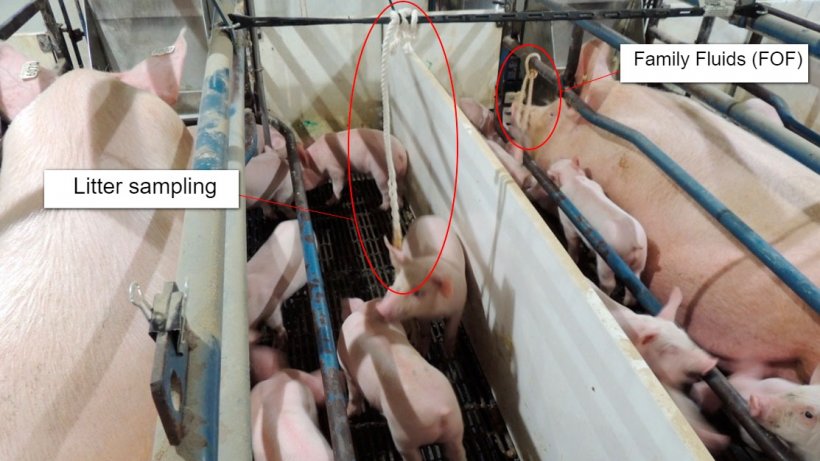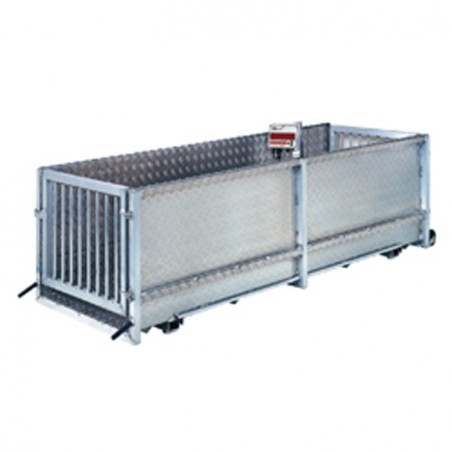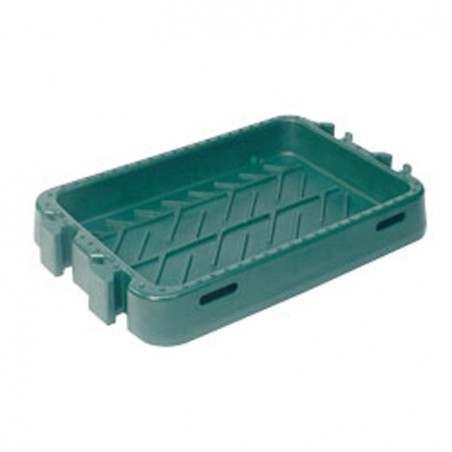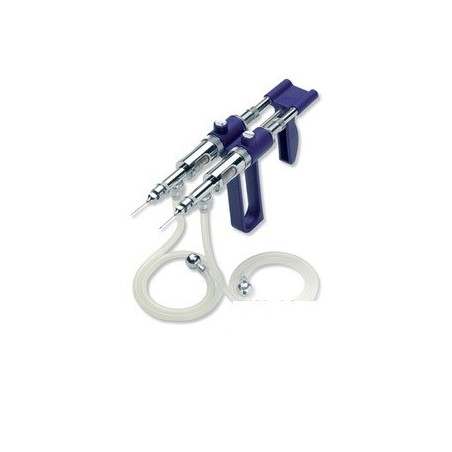Introduction
Conventional monitoring for PRRS in North American breeding herds consist of routinely testing blood serum samples from suckling piglets. However, collecting blood samples is time consuming, costly, requires handling of pigs by 2 trained persons and may cause stress/death of pigs. As result, many veterinarians choose to bleed pigs at a monthly frequency, making it challenging for early detection of PRRS outbreaks. We hypothesize that development of a reliable and practical oral fluids-based surveillance of suckling pigs will allow veterinarians to significantly improve PRRS surveillance protocols by sampling more frequently and representing more animals, which would decrease the time-to-detect PRRS outbreaks, and/or detect virus at low prevalence in herds approaching stability.

Oral fluids-based testing has been explored for growing pigs and adult animals (boars and gilts/sows) with success. However, there is limited data in the literature on obtaining oral fluids from suckling piglets.
The objective of this report is to summarize findings on attempts to establish successful and standardized procedures for oral fluid collection from suckling piglets.
Methods
Five field studies were conducted to explore the effect of family oral fluid sampling (exposing sows and piglets to a cotton rope) and litter oral fluid sampling (exposing only piglets to a cotton rope) (Figure 1). Other factors evaluated included flavoring of ropes, time of the day for sampling and rope length on the success rate of obtaining oral fluids from suckling pigs (table 1).

Table 1- Design of 5 studies to assess the effect of specific factors on the success rate of obtaining oral fluids from suckling pigs.
| Study | Objectives | Sample size |
| Study 1 | Compare family vs. litter sampling. | 20 sows and respective litters |
| Effect of training on previous day | 20 sows and respective litters (training day used as control) | |
| Effect of flavoring ropes with peanut butter | 10 sows and respective litters | |
| Study 2 | Effect of flavoring ropes (soy sauce, peanut butter, chocolate syrup, apple vinegar and sugar) | 10 litters – each litter exposed to 5 flavored ropes and 1 control rope |
| Study 3 | Compare family vs. litter sampling | 25 sows and respective litters |
| Study 4 | Compare family vs. litter sampling | 39 sows and respective litters |
| Study 5 | Compare family vs. litter sampling | 36 sows and respective litters |
For the all of the studies a successful collection was defined as extracting at least 0.5 ml of oral fluids from the cotton ropes. Success rate was therefore the proportion of successful oral fluid collections divided by the total number of litters or sows and litters exposed to ropes.
Results and discussion
In our experience, collecting oral fluid samples from suckling piglets is not as simple as it is from older pigs. However, there were factors that positively influenced the success rate of obtaining oral fluids from suckling pigs (table 2).
Table 2- Summary of success rate to obtain oral fluids from suckling pigs at 5 field studies.

| Objective | Study 1 | Study 2 | Study 3 | Study 4 | Study 5 |
| Litter vs. Family sampling | |||||
| Overall (%) | 88 vs. 100 | 0* | 84 vs 88 | 0 vs 67 | 14 vs 56 |
| Control rope vs flavored rope (%) | 60 vs. 50 | 0 | - | - | - |
| Previous training vs. no training | 75.0% vs. 55.0% | - | - | - | - |
| Age of piglets (days) | ~21 | ~ 14 | ~21 | ~14 | ~18 |
| Time of the day | 6 - 7 AM | 8 - 9 AM | 6 - 7 AM | 8 - 9 AM | 8 - 9 AM |
| *Litter sampling only | |||||
Family sampling success rate varied from 55.56% to 100.00% among the studies. For litter sampling the success rate varied from 0.00% to 88.00%. When sows had access to ropes, piglets also interacted with them, following the behavior of their dam. When piglets were exposed to ropes without prior training, 30 minutes were not enough to leave sufficient oral fluids on the ropes. Interestingly, when piglets had prior training the overall success rate from litter sampling improved 20 percentage points. This suggests that piglets either need an older animal to “teach” them how to interact with ropes, or some previous training to have an improved success rate of oral fluid collection.
On study 1 we evaluated the peanut butter as a substrate on the ropes, aiming to make the “flavored ropes” more attractive to piglets. Peanut butter slightly improved the success of collection by approximately 10 percentage points. However, when trying to understand if other substrates would be better for making ropes more attractive, no samples could be retrieved. There are two possible explanations for this: 1) the age of piglets, being 14 days old on average, and results of other studies (discussed below) demonstrated older piglets to have better success rates than young ones; and/or 2) those piglets had no prior training, nor their dams.
As previously discussed, age was a factor significantly associated with success rate of litter sampling collections. When piglets were around 21 days of age they had a better success rate (study 1 and 3) compared to trials with younger piglets (studies 2, 4 and 5). One possible explanation is that piglets get more curious as they grow older, and therefore will interact more with their environment.
Another factor that influenced the success rate of litter sampling collection was time of the day when rope exposure started. The earlier the rope exposure started the higher the success rate (study 1 and 3). This is likely due to increased piglet activity. Earlier in the day, when sows were feeding, piglets were more prone to interact with ropes. Later in the day, after sows were fed and piglets had nursed, they became less active or slept. On studies 1 and 3 the rope exposure to pigs started at 6AM and those studies had the higher success rate among all studies. Detailed results of study 1 are shown on figure 2.

Moreover, rope height (from floor) was also associated with successfully obtaining oral fluids. When ropes were closer to the farrowing crate floor, piglets seemed to interact more with them compared to a rope hanging 3-4 inches from the floor.
Conclusions
Practical, fast, easy, cost-effective and reliable methods for sampling pig populations is needed to establish ongoing and effective disease surveillance of the swine industry. Oral fluids sampling offer those characteristics, but it has not been easy or practical to obtain such samples from suckling piglets. Thus, we conducted a series of field studies to characterize factors positively associated with increased success rate of obtaining oral fluids from suckling pigs:
- Piglet age: ≥ 3 weeks old pigs had better success rate than younger pigs.
- Time of the day: the earlier it was the rope exposure, the higher it was the success rate. (Best ~ 6 AM; Poor ≥ 8 AM).
- Substrate: peanut butter slightly improved success rate for litter sampling (compared to nothing) (requires additional labor to pre-soak ropes).
- Rope height from floor: the closer the rope was from the floor the easiest it was for piglets to interact with it.
- Family vs. litter sampling: family sampling had significantly better results compared to litter sampling (success rate and volume).
- Prior training: prior training improved the litter sampling success rate.









